OCZ Vertex 460 (240GB) Review
by Kristian Vättö on January 22, 2014 9:00 AM EST- Posted in
- Storage
- SSDs
- OCZ
- Indilinx
- Vertex 460
Random Read/Write Speed
The four corners of SSD performance are as follows: random read, random write, sequential read and sequential write speed. Random accesses are generally small in size, while sequential accesses tend to be larger and thus we have the four Iometer tests we use in all of our reviews.
Our first test writes 4KB in a completely random pattern over an 8GB space of the drive to simulate the sort of random access that you'd see on an OS drive (even this is more stressful than a normal desktop user would see). I perform three concurrent IOs and run the test for 3 minutes. The results reported are in average MB/s over the entire time. We use both standard pseudo randomly generated data for each write as well as fully random data to show you both the maximum and minimum performance offered by SandForce based drives in these tests. The average performance of SF drives will likely be somewhere in between the two values for each drive you see in the graphs. For an understanding of why this matters, read our original SandForce article.
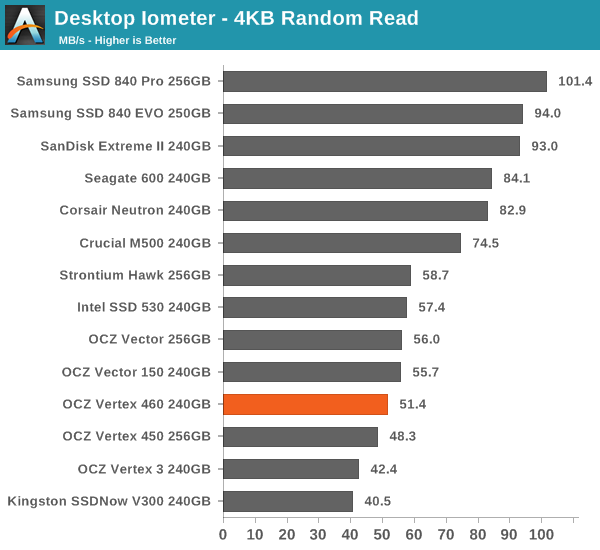

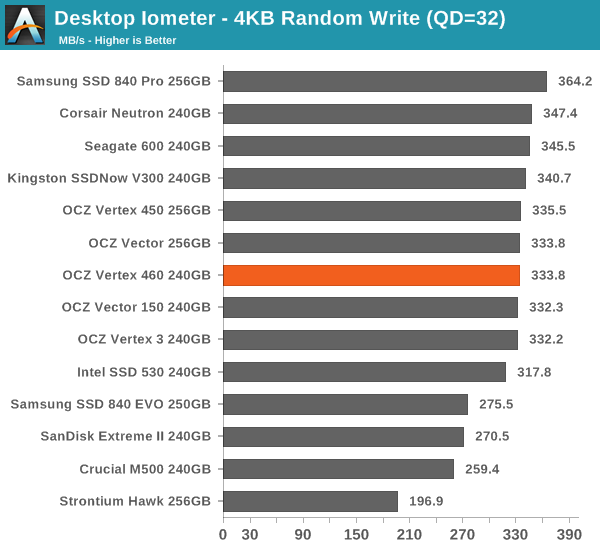
In random read/write tests the Vertex 460 and Vector 150 trade punches but the differences are minor. Our Vector 150 sample was tested a few months back so minor differences in firmware could account for the increased random read/write results, or it may simply be margin of error.
Sequential Read/Write Speed
To measure sequential performance I ran a 1 minute long 128KB sequential test over the entire span of the drive at a queue depth of 1. The results reported are in average MB/s over the entire test length.
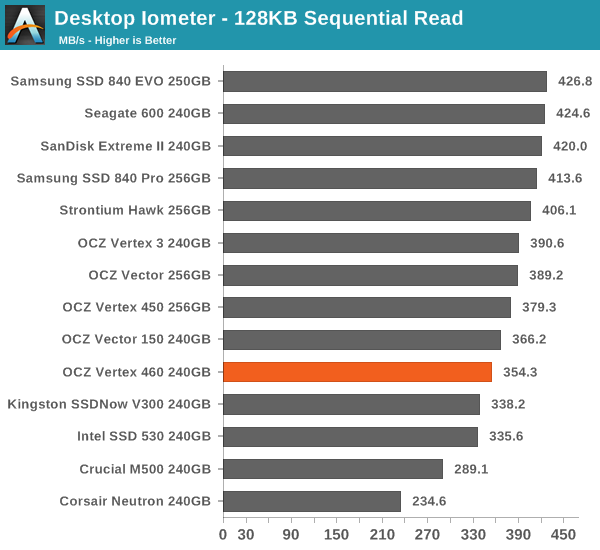
Same goes for sequential performance: the Vertex 460 and Vector 150 perform more or less equally.
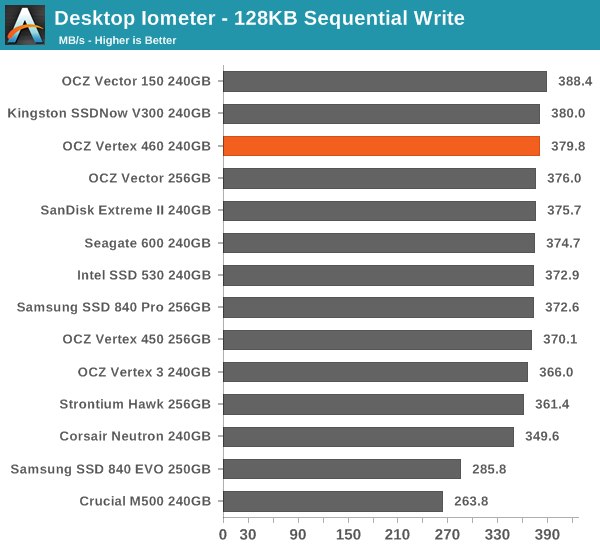
Sequential performance gives the Vector 150 a slight edge in both read and write results, but the difference is only a few percent at most.
AS-SSD Incompressible Sequential Read/Write Performance
The AS-SSD sequential benchmark uses incompressible data for all of its transfers. The result is a pretty big reduction in sequential write speed on SandForce based controllers.
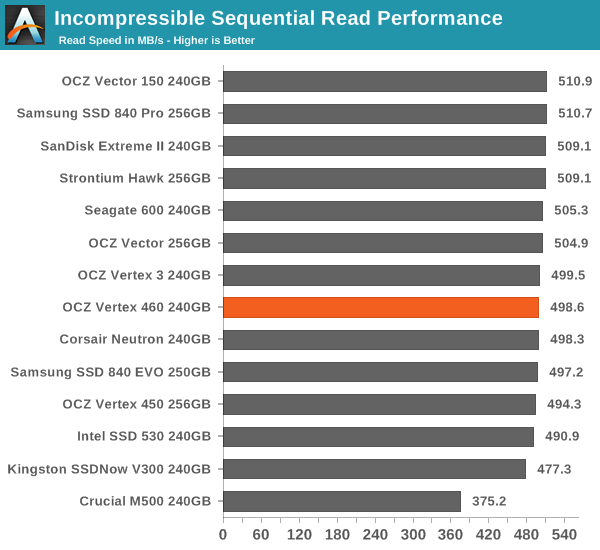
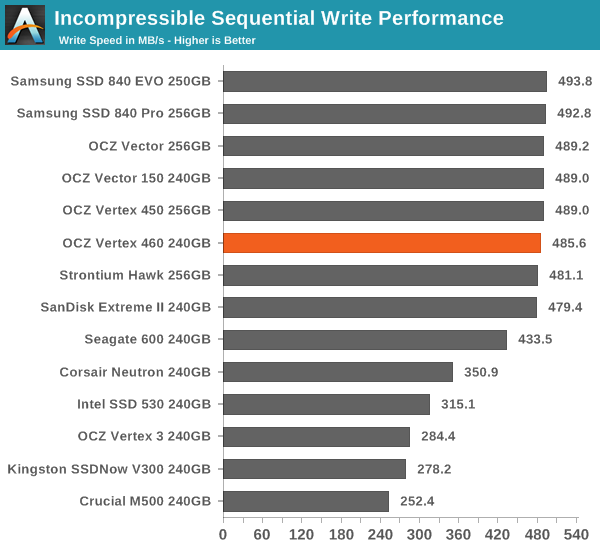










69 Comments
View All Comments
dgingeri - Wednesday, January 22, 2014 - link
This thing has the same problem as my Vertex 4 drives. I'm not impressed. It essentially means that half the capacity is unusable due to the way the controller works.Guspaz - Wednesday, January 22, 2014 - link
Hrrm. Getting merged into Toshiba's SSD group is about the only thing that might have tempered my "never again" position on OCZ. By keeping them independent, they're doing nothing to convince me that they're going to change their ways. It's their own questionable decisions that got them into this mess (their reputation for poor reliability), sacrificing reliability at the alter of performance and shipping first.dgingeri - Wednesday, January 22, 2014 - link
You think the Toshiba name is good reliability? I have 224 enterprise hard drives that would say differently. Four years ago, I got 204 Fujitsu/Toshiba (just after Toshiba took over) 146GB 15k SAS drives. Over the course of the first three years, I replaced 165 of them, plus 19 of the replacements that came in as Toshiba branded drives with the same model number. After the warranty ended, I have had to replace the remaining ones by purchasing new ones. None of them are left now. All have been replaced with Seagate Saavios of the same size. They are worse than any desktop level hard drives I have dealt with in my career. I've only had one incident like it, and that was replacing Dell Optiplex motherboards with embedded TNT2-m64 chips back in 2000.Guspaz - Wednesday, January 22, 2014 - link
Seagate has rather questionable reliability themselves (see BackBlaze's recent study on this), but Toshiba's hard disk division is unrelated to their SSD division, so the reliability of one doesn't necessarily give any indication about the reliability of the other.dgingeri - Wednesday, January 22, 2014 - link
In the 2.5" enterprise hard drive market, Seagate has been top of the heap for a long time. They really do well in that arena. There aren't a whole lot of players in that arena, though. Only Seagate, Toshiba (formerly Fujitsu,) and Hitachi. Seagate's Saavio line happens to be the first line ever in 2.5" 10k or 15k drives.As far as desktop drives go, Seagate's desktop drives have had reliability problems for years, sure, but they aren't near as bad as Toshiba's desktop drives.
Dahak - Wednesday, January 22, 2014 - link
Wonder if ocz will use/can use toshiba's ssd team for addition support(firmware/validation)even though they are separate entitiesAlso found it funny that while reading this review I had ads for Crucial's SSD :)
MrSpadge - Wednesday, January 22, 2014 - link
Otherwise the aquisition wouldn't make much sense, would it? Keep them somewhat separate but use any synergetic benefits.Dahak - Wednesday, January 22, 2014 - link
I would think so too but the way it is worded in the article seems like they wontpiroroadkill - Wednesday, January 22, 2014 - link
Why don't you just review a rock or a potato? Because I doubt many people want to purchase OCZ products.toyotabedzrock - Wednesday, January 22, 2014 - link
It might be a good idea to not copy and paste the same explanation of the tests in every article.Just link to the information. It is just headache inducing that I have hunt for relevant information interleaved with the copy and pasted parts.